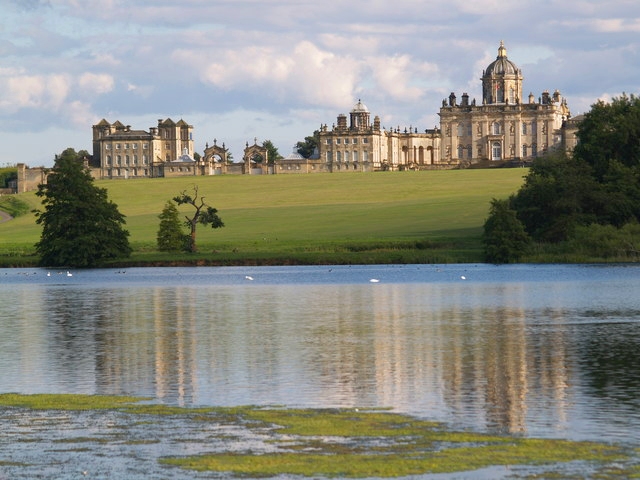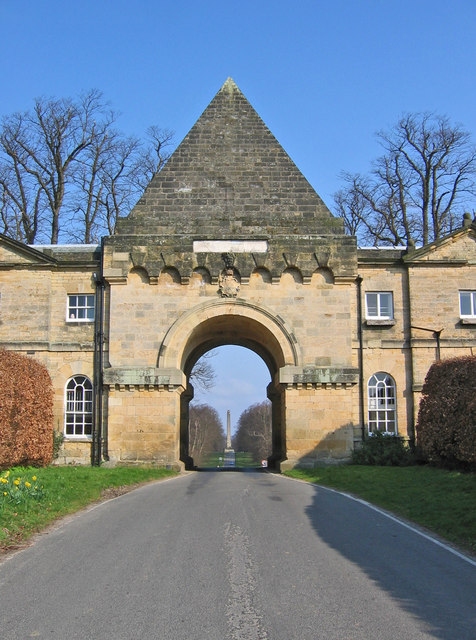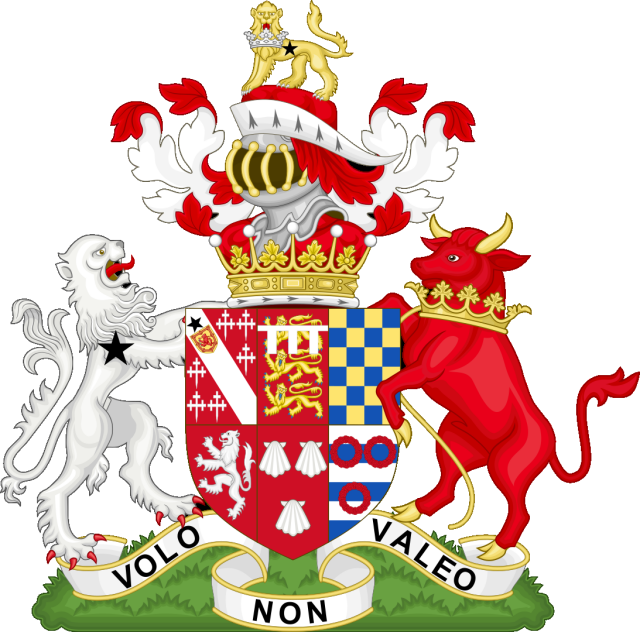
Before long we find ourselves in the almost deserted car park of Castle Howard. Since photographs are not allowed inside the House, we leave our cameras in the car. Through the entrance courtyard and the admission center we wander, then we board a little train with the few others visitors to ride out to the castle. The winding path takes us through dripping trees and along a green adorned with a huge statue of a boar. We show our ticket stubs at the door and enter into a magnificent foyer. I immediately realize that Castle Howard is more – much, much more – than I ever could have imagined.
We spend at least a half an hour in the foyer and on the grand staircase oohing and aahing over the portraits, Roman busts and china displayed in a Victorian mahogany cabinet at the top of the stairs. Two things catch my eye here: One is a portrait that is so lifelike it looks as if the man could step right out of it; it's obviously modern, and I realize later, when reading the guidebook I purchase on our departure, that the portrait is of Simon Howard, who currently resides at the castle with his wife.
The other thing that stops me in my tracks on the landing is an immense floral arrangement of roses and delphiniums. The flowers are so perfectly shaped and so large that I just know they can't possibly be real. A quick sniff-and-touch test proves me wrong.
Directly off the landing is a short corridor leading to a captivating Roman sculpture, but the passageway is cordoned off. "Oh no," I say to Robin, with some disappointment. "I have to see that." She points out that the posts and ropes seemed to be guiding us on an informal path through the house and that we will probably come back around to it. I follow reluctantly, looking over my shoulder as we leave the statue behind.
There is so much to see – so many bedrooms with high four-poster beds draped in brocades and silks. One room holds a smaller bed with an embroidered and appliquéd spread completely covered with figures from fairytales and ballads. A plaque on the wall tells the story of a young mother nursing her ill child, relating tales as she stitched by the bedside. A quiltmaker myself, I can appreciate the time and creativity that went into this coverlet.
Finally, we make our way back to the Antique Passage and sitting regally at one end is a marble statue of a maiden – the sculpture I'd seen from the foyer. Up close we can see where restoration work has been completed on her face. I have to put my hands on it and look around for a sign saying that I am not permitted to do so. No sign in sight, I cup her face between my hands, marveling at the smooth coolness. The corridor is lined with busts, statues, urns and inlaid marble tabletops of incredible complexity. Sunlight streams in through towering windows. This is definitely how "the other half" lives.
From the Antique Passage we enter the Great Hall, with its domed ceiling painted with figures depicting the Four Elements, the Twelve Figures of the Zodiac and Apollo and the Muses. Massive columns carved with leaves and scrolls rise in the four corners. More busts and statues are tucked into arched alcoves.
We pass through the Music Room, complete with harp and spinet piano. The marble fireplace is decorated with vines, fruits and a ram's head. Then onto the Orleans Room, which boasts landscapes on the lofty walls and a backgammon table with intricately inlaid wood. I can almost see men in embroidered waistcoats and powdered wigs with snifters of brandy in hand, laughing and playing at that table.
A wide corridor floored in gleaming hardwood leads to the Museum Room which is hung with more portraits and landscapes. A delft tulip vase about two feet tall is only one of the treasures in this room. There are also two cabinets inlaid with marble and semiprecious stones. Everywhere, in every room, the scent of flowers greets us as we enter. One of the guides, who are stationed throughout the house ready to answer any questions visitors may have, remarks that they have a new gardener this year and we send our compliments along.
The Long Gallery is lined with oak bookcases that hold over 20,000 volumes. I would be happy to browse here for hours just reading the titles. The only disappointment I find is a room dedicated to the filming of the Brideshead Revisited television series. A make-up table, cast off scripts and costumes fill the room. I suppose many people make a pilgrimage to Castle Howard spurred by their enjoyment of this program. I shrug and moved on.
Entering the chapel lobby, we murmur in hushed voices as we point out yet more opulent miscellanea to one another: a bronze monkey holding a half of a peach which acts as a shallow bowl, glass pig flasks and a spade and wheelbarrow with ties (no pun intended) to the early railway system. In the chapel itself, I stop and stare in awe at the stained glass windows and tapestries. The pulpit and choir pews are intricately carved. A mosaic tile panel covers much of the area before the altar and twelve grand columns, decorated with gold scrolls rise to the decorated ceiling.
Smaller red marble columns stand on either side of a portrait of Jesus, which hangs above the altar. Robin and I have quite a discussion about this portrait. It depicts Jesus after the crucifixion, as he has a halo around his head, but he is draped as a Roman figure, leaning nonchalantly with his elbow resting on a pillar. Very strange indeed.

Castle Howard is a stately home in North Yorkshire, England, 15 miles north of York. It is a private residence, and has been the home of the Carlisle branch of the Howard family for more than 300 years.
Castle Howard is not a true castle, but this term is also used for English country houses erected on the site of a former military castle.
Building of Castle Howard began in 1699 and took over 100 years to complete to a design by Sir John Vanbrugh for the 3rd Earl of Carlisle. The site was that of the ruined Henderskelfe Castle, which had come into the Howard family in 1566 through the marriage of Thomas, 4th Duke of Norfolk to Elizabeth Leyburne, widow of Thomas, 4th Baron Dacre.
Read more about Castle Howard at Wikipedia.

The Howards have played an important role throughout much of English and later British history. Claiming descent from Hereward the Wake, the resister of the Norman conquest who has been much celebrated in folklore, John Howard fought to the death at the Battle of Bosworth Field in defense of the cause for the House of York.
They regained favor with the new Tudor dynasty after leading a defense of England from Scottish invasion at the Battle of Flodden, and Catherine Howard subsequently became the fifth wife and Queen consort to King Henry VIII.
Read more about the House of Howard at Wikipedia.